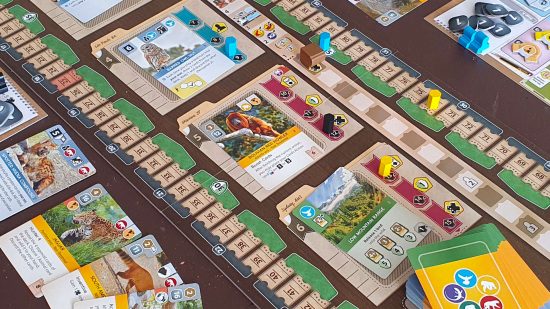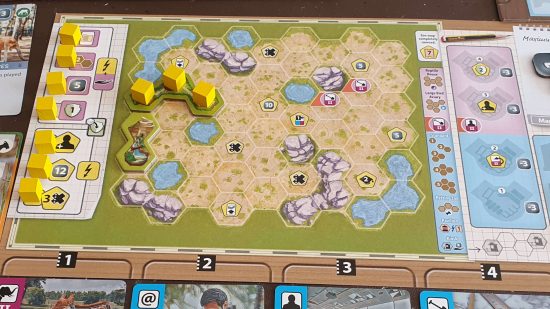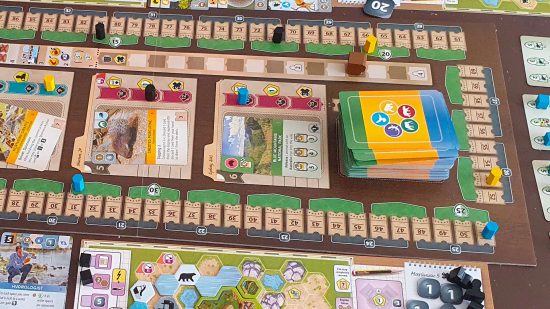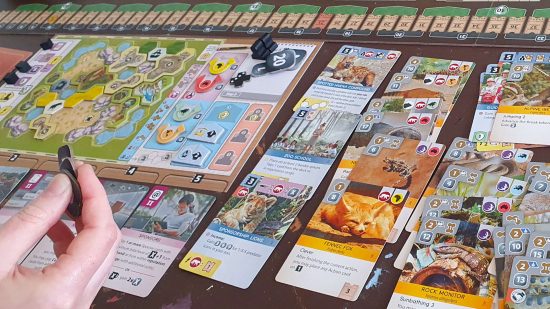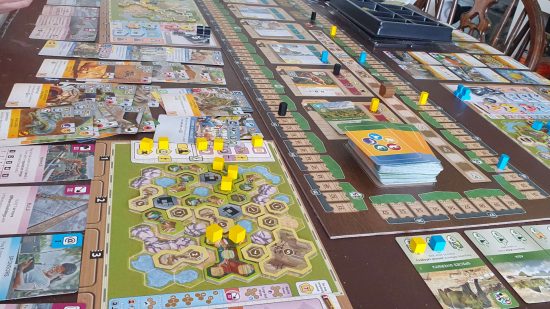Our Verdict
A heavyweight strategy game with loads of content and a remarkable attention to the details of the zoo industry.
My partner worked her way up from a weekend keeper to the manager of a small zoo over the course of a decade. Midway into our first game of Ark Nova, she said to the table: “I think actual zoo keepers must have made this… that, or they hired consultants.” Ark Nova is incredibly rich in theme, but unless you know the zoo business, you might not realise quite how rich.
Ark Nova is a heavyweight euro game, and one of the best board games for fans of hard decisions. Some of the game’s most interesting mechanics might look like arbitrary euro game systems, but they’re faithful adaptations of parts of the zoo business that most people simply know nothing about.
In Ark Nova, each player starts with a hex-grid map of an empty plot. Over the course of the game you’ll fill it with the enclosures, concession stands, and sundry special features that make up their zoo. Your goal is to create a zoo that appeals to visitors and is a centre of animal conservation.
Tracks measuring your zoo’s Conservation output and Appeal to visitors run around the edge of the game’s central board. The tracks proceed in opposite directions, and when any player’s appeal marker passes their conservation marker the end of the game triggers. Your final score depends on how large a gap you can create between those two markers – finishing with a negative score is perfectly possible.
Appeal is at the heart of your zoo’s economy, determining how much cash you’ll generate each time the game moves to a break. Bringing animals into your zoo will increase its appeal, but each animal requires housing in an appropriately sized enclosure, and to meet any other special requirements.
Those requirements are handled via a tableau of icons you build up as you add animals and other elements to your zoo; a nile crocodile might add an Africa icon and a Reptile icon to your zoo, a partnership with a university adds two research icons, and so on.
On a player’s turn they’ll select an action from the five available to them. They’re arranged in a row, and the order is important; the further to the right the action is, the more impactful it will be. Once taken, an action slides to the far left.
Most of these are simple. ‘Build’ lets you spend money to put empty enclosures and other buildings into your zoo. ‘Animals’ lets you pay money to play animal cards from your hand into empty enclosures. ‘Cards’ lets you do a little bit of admin, drawing new cards from the enormous central deck or the central spread while pushing the next break a little closer.
‘Sponsors’ are a grab bag of permanent effects that you can add to your zoo, and could be anything from a zoo vet, to a cable car, to a research centre, and so on.
It’s easy enough to see the zoo theme in these actions; they all interact with the physical space of your zoo, or add to the tableau of cards representing its animals and other assets, or simply refill your options as your staff do a bit of paperwork. The last action, ‘Association’, takes things outside your zoo, and onto the conference circuit.
Association is the only action limited by worker placement. Depending on the strength of the Association action you take, you can send workers off to achieve different effects: they can boost your Reputation in the zoo community, strike a partnership with a university or an international zoo, or start or participate in a conservation project.

There’s just so much character in the association action. Zoos are an interdependent global network, and networking is essential for zoos to function: zoo conferences share knowledge, set up partnerships, help ensure neither the animals nor the ideas in a zoo become inbred. But there’s still rivalry between zoos, particularly over who has the best standing as a bastion of conservation – and that competition is exactly what the conservation projects in Ark Nova demonstrate.
Conservation projects are where you’ll get the bulk of the Conservation points each game, provided you meet their requirements when you take the Association action. Games begin with a number of basic conservation projects in play. They might simply require your zoo contain several icons from (for example) Asia, or different continents, or primates.
If you have the right cards you’ll be able to play advanced conservation projects. That might be a conservation breeding programme that requires you to have both an animal of a certain type and a partner zoo in the corresponding country; or a release programme, in which case you need to let go of an animal from your zoo, reducing your appeal and freeing up its enclosure.
Animal releases are very rare, in Ark Nova and in the real world. The majority of zoo conservation output is through public education, fundraising to preserve habitats, research, and maintaining genetically viable ‘ark’ populations against the slim chance they will be able to be reintroduced in the future, if humans ever permit their native habitats to recover.
The Reputation track sits alongside the central display of cards. Where Appeal represents a zoo’s consumer offer, the Reputation track is the zoo’s standing in the community. It’s possible to upgrade your action cards during the game, and once that’s done you’re able to use cards directly from this display, provided your reputation marker has reached that card’s position.
This is spot on. Zoo animals can’t be sold, but they often need to be moved. When a snow leopard breeds the cubs will eventually have to leave the mother, and there’s only so many elephants you can fit in a stables. Where do those babies go? A zoo’s standing in the community could be the deciding factor in whether or not it gets a highly desirable animal.
This is just a cursory overview of Ark Nova. The game is overwhelmingly generous with content. End-game scoring cards will push you in certain directions early on, but hundreds of unique cards and distinct animal abilities will throw new options at you continually. As well as a beginners and a regular map for your zoo grounds, there are eight unique boards with special effects to trigger
There are a few problems. I laugh heartily about finishing with a negative score, but it won’t appeal to everyone. Some animals and sponsors are simply impossible to play in the first few rounds of the game, due to their costs or requirements, and while you’ll choose your initial hand of four cards from a draw of eight, it’s still possible to get a rubbish starting hand. Lucky draws can give a player a powerful boost in Conservation or Appeal, which could sting in a three hour game.
Overall Ark Nova is a remarkable fusion of theme and systems. Every turn forces hard choices onto the player as they try and turn the money, cards, tableau, and zoo layout in front of them, into progress. That it’s also an authentic interpretation of a side of the zoo industry the public never gets to see is a surprise and a delight.
